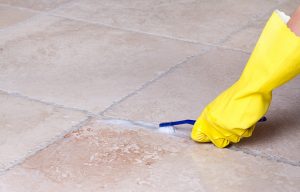Grout and mortar share similar raw materials, including cement but they have very different consistencies. The bedding material used in masonry is more gritty than smooth, while the mixture used to fill gaps in kitchen and bathroom tiles is fluid and fine.
Since you are here to learn a few things about laying down floor tiles, we’ll give you essential insights. We have insider information from tile grout cleaning companies you’d want to read and apply to your own DIY project.
Lines for structure and stability
Grout is thin. It can be poured. It may seem like an optional product for laying down tile floors, but in truth is plays an important role. The adhesive used between tiles made from slate, marble, granite, and clay-based ceramics is not for aesthetics only.
The material keeps the tiles from cracking and breaking. Even concrete flooring can use the stability offered by grout lines and joints. They add structure and resilience, and therefore must never be underestimated, or its upkeep neglected.
Sealing: The first line of defense
Protecting adhesive lines is a priority. One of the characteristics of the adhesive between tiles is porosity. The very essence of the material that makes it easy to apply also offers a disadvantage.
Penetrating substances and stains can mar the adhesive lines. Mildew and mold would damage the adhesive given time. Indeed, it is necessary to seal the joints as soon as they are dry.
After curing, a sealant adds protection and makes it durable — resilient to stains and grime. Contaminants will not stand a chance against kitchen grease, and the oils that touch bathroom tiles will wash away.
 Waterproofing: The second line of defense
Waterproofing: The second line of defense
Aside from sealing, it is now possible to add another level of protection to the adhesive joints. An additive can be added, which protects the grout from fluids.
Once waterproofing is in place, the contaminants will have no chance to infiltrate the material and start ruining it from within. Waterproofing is especially necessary for areas like dirty kitchens, baths, and swimming pools.
Epoxy grouts: For your consideration
Current developments in grout technology have made epoxy grout available to every household in America. It is more expensive than the typical adhesive, and it sets up quickly.
The difference in this product from the traditional form is the lack of water and cement. It contains, among other things silica fillers, hardener, and epoxy resin, of course. The main advantage of epoxy grout is its low porosity.
For best results, the product must be handled only by people who have experience in laying it down. Modified epoxy grout is more reliable and stain-resistant. Consider using this product if you need extra strength and reliability.
Grout has high water content and fills the spaces between tiles laid out on the kitchen and bathroom floors. There are variations, and the question of which product suits your floor best depends on many factors. For best results let experienced handymen place the fluid and form the lines that will protect your floor and keep the tiles intact for many years to come.

